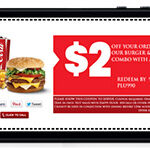Two thirds of consumers have been tempted into buying by a coupon (source: Gutscheinbarometer 2014). According to studies by RetailMeNot and Deals.com, one in 5 coupon users has spent more money on a purchase than initially anticipated. No wonder that (digital) coupons have established a fixed place in marketing. We have compiled 4 tips for you on the correct use of coupons in marketing.
1. Try Different Types of Coupons
Discount coupons (“save 10%”) are the most commonly used type of coupon. However, the benefits of coupons do not need to be limited to discounts . Free gifts are also very popular. In the case of FMCG (Fast Moving Consumer Goods), offers such as “3 for 2” might make sense. Other products can be combined with cross-sells, e.g. “1 free game when you buy an XBox One”. Free gifts however, do not need to be linked to the purchase of a specific product. Coupons can be useful, e.g. to promote a newly introduced FMCG: “with each purchase we are giving away a pack of the new Nivea face cream”.
More ideas for coupons are, e.g. free delivery or additional premium services: Same day delivery, invitation to an exclusive event, the (temporary) membership to a club, etc.
2. Operate and Optimise Across All Channels
Users today move in a complex digital eco system of different digital channels. This means, coupon marketing needs to operate channel-wide, too. Email, Web, SMS, social media, mobile messengers etc. are all suitable channels for coupons. However, you must bear in mind that users differentiate less and less between channels but expect a consistent experience. In marketing, this does not only mean that you need to optimise the coupons for each channel (e.g. through responsive designs in email marketing) but also integrate the channels in a cross-functional way. For example, an SMS coupon should not only work in the shopping app but also in the web shop or at the PoS.
3. Use Different Occasions in the Lifecycle
The customer lifecycle is waiting with a large number of touchpoints where coupons can be used successfully. Examples:
– New customer acquisition: New customers receive a coupon with their first purchase which can also be used immediately.
– Opt-in generation: The subscription to a newsletter can be incentivised through a coupon.
– Customer retention Existing customers can be retained with coupons. The type of coupon can match, e.g. the length of the customer relation, the purchase frequency or the attained sales. New loyalty points which can be exchanged for coupons, are another option.
– Increase of the shopping basket value Coupons can be linked to the shopping basket value in order to increase it. “10GBP off with your order over 100GBP, 10GBP off with your order over 150GBP etc.”.
– Shopping basket cancellation: Shopping Basket Cancellation Does Not Equal Shopping Basket Cancellation Customers who have abandoned the purchase process (e.g. because the price was too high) can be remotivated to continue with the purchase if they receive a coupon.
– Reactivation of inactive customers: Customers who have not purchased anything for a while, can be reactivated through coupons.
– Recommendation: A recommendation via email, social media or product feedback in the shop can be rewarded with a coupon.
4. Individualise Coupons
Individualising is one of the most essential success factors in email marketing. This also applies to coupons. Coupons are particularly effective when they do not just work based on the system “available to everyone, 10% off everything” but are customised for each user. This means you need to look at the customer status (also see Customer Retention under 3), at the previous coupon redemption (has the user, e.g. only redeemed coupons for free delivery but not for percentage discounts?) and in particular at the customer’s product preferences (20% off the new model of his favourite shoe brand).
